ALMA sees wreckage of comet collisions in nearby solar system
Astronomers using the Atacama Large Millimeter/submillimeter Array (ALMA) telescope in northern Chile have today announced the discovery of an unexpected clump of carbon monoxide gas in the dusty disc around the star Beta Pictoris. This is a surprise, as such gas is expected to be rapidly destroyed by the star’s UV radiation. Something — probably frequent collisions between small, icy objects such as comets — must be causing the gas to be continuously replenished. The new results are published today in the journal Science.
Beta Pictoris, a nearby star, located approximately 63 light-years from Earth in the southern constellation Pictor, easily visible to the naked eye in the southern sky, is already hailed as the archetypal young planetary system. It is known to harbor a planet that orbits some 1.2 billion kilometers from the star, and it was one of the first stars found to be surrounded by a large disc of dusty debris [1].
New observations from ALMA now show the disc is permeated by carbon monoxide gas. Paradoxically, the presence of carbon monoxide, which is so harmful to humans on Earth, could indicate that the Beta Pictoris planetary system may eventually be a good habitat for life. If there is carbon monoxide in the comets, then there is likely also water ice, meaning that the cometary bombardment that its planets are currently undergoing could also be providing them with life-giving water [2].
Credit: NASA's Goddard Space Flight Center/ Aki Roberge.
But carbon monoxide is easily and rapidly broken up by starlight — it can only last about 100 years. Seeing it in a disc of this age is a complete surprise. So where did it come from, and why is it still there?
"Unless we are observing Beta Pictoris at a very unusual time, the carbon monoxide must be continuously replenished," said William R.F. Dent, astronomer at the Joint ALMA Office in Santiago, Chile, and lead author on a paper published today in the journal Science. "The most abundant source of carbon monoxide in a young solar system is collisions between icy bodies, from comets up to larger planet-sized objects."
But the rate of destruction must be very high: "To get the amount of carbon monoxide we observe, the rate of collisions would be truly startling — complete destruction of a large comet once every five minutes," noted Aki Roberge, an astronomer at NASA’s Goddard Research Center in Greenbelt, USA, and coauthor of the paper. "To get this number of collisions, this would have to be a very tight, massive swarm."

The ALMA image of carbon monoxide around Beta Pictoris (above) can be deprojected (below) to simulate a view looking down on the system, revealing the large concentration of gas in its outer reaches. For comparison, orbits within the Solar System are shown for scale. Credit: ALMA (ESO/NAOJ/NRAO) and NASA's Goddard Space Flight Center/F. Reddy
But there was another surprise in the ALMA observations, which did not just discover the carbon monoxide, but also mapped its location in the disc through ALMA’s unique ability to simultaneously measure both position and velocity: the gas is concentrated in a single compact clump. This concentration lies 13 billion kilometers from the star, which is about three times the distance of Neptune from the Sun. Why the gas is in this small clump so far from the star is a mystery.
"This clump is an important clue to what is going on in the outer reaches of this young planetary system," says Mark Wyatt, an astronomer at the University of Cambridge, UK, and a co-author on the paper. Stuartt Corder, ALMA deputy director and also co-author on the paper, adds: "Gas of the type we are detecting is easy to destroy quickly if it is left floating around in these quantities. The only way this gas survives in disks younger than Beta Pictoris is that it is protected by dense material. Since this is not the case, it needs to be generated anew on relatively short timescales. The only real option for this is comets."
Both of these possibilities give astronomers reason to be optimistic that there are many more planets waiting to be found around Beta Pictoris. "Carbon monoxide is just the beginning — there may be other more complex pre-organic molecules released from these icy bodies," adds Roberge.
Further observations are planned with ALMA, which is still ramping up to its full capabilities. "ALMA should allow us to see more of this type of emission and enable us to determine when and how comets deliver gas, and in principle water, to the inner reaches of their young solar systems where rocky planets could support life,"states Corder. This would shed more light on this intriguing planetary system, and so help us understand what conditions were like during the formation of our own Solar System.
Notes
[1] Many stars harbor such dust, known as debris discs. They are the remains of a collisional cascade of the rocks in orbit around the star, much like the collisional breakup of the space station depicted in the movie Gravity (but on a much larger scale).
[2] Comets contain ices of carbon monoxide, carbon dioxide, ammonia and methane, but the majority component is a mixture of dust and water ice.
More Information
The Atacama Large Millimeter/submillimeter Array (ALMA), an international astronomy facility, is a partnership of the European Organisation for Astronomical Research in the Southern Hemisphere (ESO), the U.S. National Science Foundation (NSF) and the National Institutes of Natural Sciences (NINS) of Japan in cooperation with the Republic of Chile. ALMA is funded by ESO on behalf of its Member States, by NSF in cooperation with the National Research Council of Canada (NRC) and the Ministry of Science and Technology (MOST) in Taiwan and by NINS in cooperation with the Academia Sinica (AS) in Taiwan and the Korea Astronomy and Space Science Institute (KASI).
ALMA construction and operations are led by ESO on behalf of its Member States; by the National Radio Astronomy Observatory (NRAO), managed by Associated Universities, Inc. (AUI), on behalf of North America; and by the National Astronomical Observatory of Japan (NAOJ) on behalf of East Asia. The Joint ALMA Observatory (JAO) provides the unified leadership and management of the construction, commissioning and operation of ALMA.
This research was presented in a paper entitled “Molecular Gas Clumps from the Destruction of Icy Bodies in the Pictoris Debris Disk” to appear in the journal Science on 6 March 2014.
The team is composed of W.R.F. Dent (Joint ALMA Office, Santiago, Chile [JAO]), M. C. Wyatt (Institute of Astronomy, Cambridge, UK [IoA]), A. Roberge (NASA Goddard Space Flight Center, Greenbank, USA), J.-C. Augereau (Institut de Planétologie et d'Astrophysique de Grenoble, France [IPAG]), S. Casassus (Universidad de Chile, Santiago, Chile), S. Corder (JAO), J.S. Greaves (University of St. Andrews, UK), I. de Gregorio-Monsalvo (JAO), A. Hales (JAO), A.P.Jackson (IoA), A. Meredith Hughes (Wesleyan University, Middletown, USA), A.-M. Lagrange (IPAG), B. Matthews (National Research Council of Canada, Victoria, Canada) and D. Wilner (Smithsonian Astrophysical Observatory, Cambridge, USA).
Contact:
Bill Dent
Joint ALMA Office
Santiago, Chile
Email: [email protected]
Valeria Foncea
Education and Public Outreach Officer
Joint ALMA Observatory
Santiago, Chile
Tel: +56 2 467 6258
Cell: +56 9 75871963
Email: [email protected]
Charles E. Blue
Public Information Officer
National Radio Astronomy Observatory
Charlottesville, Virginia, USA
Tel: +1 434 296 0314
Cell: +1 434.242.9559
E-mail: [email protected]
Richard Hook
Public Information Officer, ESO
Garching bei München, Germany
Tel: +49 89 3200 6655
Cell: +49 151 1537 3591
Email: [email protected]
Masaaki Hiramatsu
Education and Public Outreach Officer, NAOJ Chile
Observatory Tokyo, Japan
Tel: +81 422 34 3630
E-mail: [email protected]

